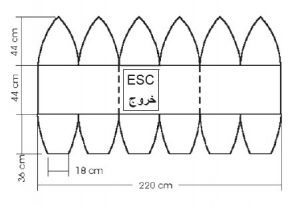A hot air balloon is something kids would love as a science project. Incorporating basic physical concepts, the step by step comes with valuable tips and ideas. It could be your go-to project at the next science fair. A handful of mini hot air balloons out of tissue paper could light up any gloomy skyline with gusto.

How to Make a Hot Air Balloon with Tissue Paper
The balloon is made of 7 gores of tissue paper. Each gore needs 2½ sheets of tissue paper. The gores can be of different colors or the same color. They can be decorated with colorful tissue paper scraps. The below procedure describes how the gores are stuck together, leaving holes at the bottom and the top. A string closes the top part while dry wall tape fixed at the bottom opening creates a throat allowing inflation.
Materials
- 18 sheets of tissue paper each of 20”X30” dimension
- 12” string
- 9 feet drywall tape
- Glue
- Hair dryer or fan
- Balloon gore template pattern
Instructions
- Make a large rectangle approx. 75”X20” by gluing together the short ends of 2½ sheets.
- Repeat the above for 6 times resulting in a total of 7 rectangles.
- With the aid of the given pattern cut out 7 gores from the rectangles created above.
- Choose 2 Lay one over the other so that a ½” margin shows on the bottom gore.
- Apply glue on the aforesaid margin. Fold it over the edge and glue to set it firmly in place.
- Place gore 3 above gore 2 so that a ½” margin of the unglued side shows on gore Repeat gluing as mentioned in the previous step.
- Glue up the remaining gores in the accordion fashion mentioned above.
- Connect the free margins of gores 1 and 7 to join all the gores. This creates a circle when opened.
[N.B. It is important to carefully separate all the folds to prevent them from sticking together]
- Use the string to tie the top of the balloon maintaining a distance of about 1” from the apex.
- Glue the pieces of drywall tape one atop the other to make a circle of approx. 12” diameter.
- Open a hole at the bottom of the balloon and fit the balloon panels by tucking and gluing them together.
- Put the tape ring inside the opening, fold paper over it for about 1” and glue it in place.
- Allow the balloon to dry fully. Check for loose edges and holes by employing the hair dryer or fan. If needed, use the glue and paper or tape to repair.
Launching
Launcher Directions
- Cut out both ends of 5 large juice cans.
- Take 1 more juice can and snip off its top. It serves as the base of the “smokestack”.
- Also, create a wedge-shaped opening at one side of the above can.
- Make 3 tiny evenly spaced holes around the tops and bottoms of all the cans.
- Thread small pieces of wire through those holes to arrange all the cans in a vertical stack.
- Wire a screen above the burner to prevent cinders from getting inside the balloon.
- Go to an open area devoid of utility wires, rooftops and trees and that has winds blowing at 5mph.
- Put fire to a lot of old crumpled newspaper at the bottom of the burner while 2 people hold the balloon at the top of it.
- When the tissue paper walls start feeling warm and the balloon tends to lift, set it free and watch it go up lazily in the air.
It would, in all probability soar for around 200 feet or more and then descend in a few minutes time.
Alternative
Instead of the burner, you can join two opposite points on the circumference of the base ring by a drywall tape strand and place a candle over it to fuel the hot air balloon.
Building a Hot Air Balloon from Tissue Paper: Video Tutorial
How Does It Work
The fundamental principle behind the flying hot air balloon is density. The heat source warms the air above making it less dense. Hence, the air entering the balloon is lighter than that outside the balloon. We know that if a body is less dense, it floats in a denser fluid. If it is denser, it sinks. That is the reason behind the flight of the hot air balloon.
Tissue Paper Hot Air Balloon Designs
Here are a few other blueprints that you can choose from. The diagrams give the best shape to your project and help you build it easily. It is important to get the measurements right during the construction of the models. Kids can make small tissue paper hot air balloons in the lab and go to a field to launch them.
Another simple idea is to take 4 rectangular panels, glue them together to form a box-shaped structure and seal off the top with a square piece. So, what are you waiting for? Gather your supplies and engage yourselves in this fun project. The more the patterns of balloons you create, the merrier.





Leave a Reply